
Source: PaxForex Premium Analytics Portal, Fundamental Insight
Johnson & Johnson experienced a significant surge of 6% in its share value during a single trading session last week. The impressive boost came as a response to their second-quarter earnings report, which surpassed investors' expectations by a considerable margin.
While a single positive quarterly report may not be sufficient reason alone to invest in J&J or any business, it's essential to examine their recent performance in light of the significant changes they underwent earlier this year to assess whether it's a favorable time to buy the stock.
In February, J&J underwent a major transformation by spinning off its consumer health segment into a separate entity called Kenvue. Despite this, J&J retains 90% ownership of Kenvue shares, and soon, J&J shareholders will have the option to exchange some, all, or none of their J&J stock for shares of the new company.
With the slow-growing consumer division no longer weighing them down, it appears to be a prudent decision to hold onto as many J&J shares as possible. After accounting for the decline in COVID-19 vaccine sales and fluctuating currency exchange rates, the pharmaceutical segment revenue witnessed a commendable 6.2% year-over-year growth in the latest quarter.
The easing of COVID-related restrictions has led to a rise in delayed surgeries, which, in turn, has boosted J&J's sales of medical devices significantly. The medtech segment experienced an impressive 14.7% year-over-year surge in constant currency exchange rates during the quarter. Furthermore, the recent acquisition of Abiomed, a manufacturer of tiny pumps used in heart surgery to maintain blood flow, proved to be a strong contributor to their success.
The stronger-than-expected performances from both the pharmaceutical and medical technology segments have prompted the management to revise their estimate for 2023 adjusted earnings. At the midpoint of the new projected range, adjusted earnings are anticipated to rise by 6% year over year, exceeding the 5% gain that was predicted three months earlier.
Over the past year, Johnson & Johnson (J&J) has reported $16.2 billion in free cash flow, a figure that has decreased since the peak demand for its COVID-19 vaccine but remains sufficient to fulfill its dividend commitments and pursue new avenues of growth.
The strong cash flow has allowed J&J to meet its dividend obligations and successfully make a $16.6 billion cash payment for the acquisition of Abiomed. The revenue directly linked to the Abiomed acquisition is projected to exceed $1.4 billion this year, and with the support of J&J's extensive international sales force, the growth potential for Abiomed-related revenue is promising.
Over the past 12 months, J&J only needed 73% of its generated free cash flow to cover dividend payments, leading to a growing cash reserve, which stood at $29 billion at the end of June. This financial strength puts J&J in a favorable position to pursue strategic acquisitions whenever suitable opportunities arise.
By divesting its slow-growing consumer health division, J&J's overall profitability could improve. However, it's worth noting that cash flow from consumer items like Q-Tips, Band-Aids, and Listerine has been fairly stable. The new, streamlined J&J may experience more volatile cash flow dynamics.
While J&J boasts several blockbuster drugs with increasing sales, their growth is hindered by older products losing patent protection. Additionally, second-quarter sales of Zytiga, a prostate cancer treatment, saw a significant 55% year-over-year decline to $227 million.
Imbruvica, a blood cancer treatment that used to generate over $5 billion in annual sales, is facing market share erosion despite maintaining patent protection. Competition from newer treatments like Calquence from AstraZeneca and Brukinsa from Beigene, which offer arguably better safety profiles, has led to a 13% year-over-year drop in second-quarter Imbruvica sales, now estimated at $3.4 billion annually.
Despite bouncing back after the latest earnings call, J&J's shares are currently trading at a reasonable 15.8 times earnings expectations. This presents a favorable opportunity to invest in a business that anticipates a 6% growth in earnings per share for the year, according to management's guidance.
Purchasing shares of J&J with a long-term perspective provides investors with a decent chance of outperforming over time. Although it may not be the highest-performing asset in one's portfolio, it is still a prudent investment choice due to its slim chances of incurring significant losses over the long run.
As long as the price is above 167.00, follow the recommendations below:
- Time frame: D1
- Recommendation: long position
- Entry point: 172.64
- Take Profit 1: 175.00
- Take Profit 2: 180.00
Alternative scenario:
If the level of 167.00 is broken-down, follow the recommendations below:
- Time frame: D1
- Recommendation: short position
- Entry point: 167.00
- Take Profit 1: 163.00
- Take-profit 2: 160.00













